If you have a diagram, a detailed description, and also subject to preliminary determination of the knitting density, you can independently Any woman can knit a warm, stylish hat. At the peak of popularity are voluminous models of headwear made of elastic, durable mohair, which go well with voluminous sheepskin coats, coats, and down jackets. If you choose a simple pattern and calculate the number of loops, then in 2-3 days you can try on the new thing.
Features of knitting hats from mohair
Mohair hats with knitting needles (patterns for beginners are easy to perform and contain a step-by-step description of the actions, due to which novice needlewomen will be able to knit the desired headdress in a short period of time) can be knitted in 2-4 days if you know the intricacies of working with this yarn.
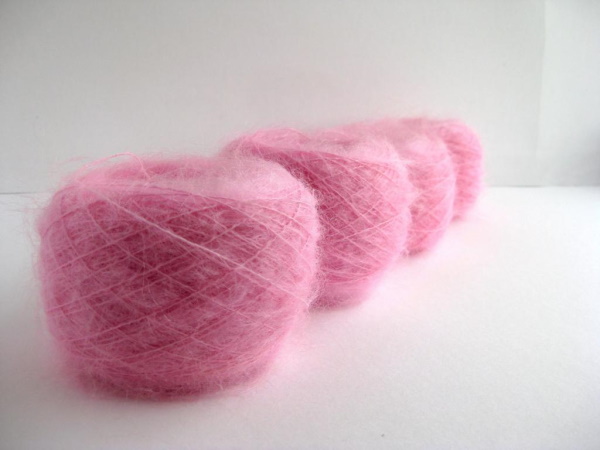
To avoid common mistakes when using mohair yarn and finished products made from this material, you need to consider the recommendations:
- When working with mohair, it is not recommended to unravel the knitted fabric. Otherwise, the villi will roll up and tangle. If the needlewoman managed to unravel the mohair product, the thread will lose its original appearance, as felted lumps of fluff will form, and bald spots will appear.
- The hat should be washed by hand in warm water with the addition of liquid washing powder that does not contain enzymes (substances of biological origin that accelerate chemical reactions). You should try to avoid changes in water temperature, as the pile may become matted.
- To work with mohair, you should choose knitting needles 2.5 cm thick or more (it all depends on the number of folds of thread and the density of the pile).
- A thin warp thread will not be able to hold a bulky elastic band.
- It is better to avoid creating small textured patterns, as they will not be noticeable in the mohair pile.
- If you use thin yarn, you will end up with a light, feminine hat, but it will not protect you from severe frosts.
The following yarns are perfect for making a headdress: Alize Kid Royal, Concept Mohair Cotton, Concept Setakid Moda, Kutnor Maira. Experienced needlewomen prefer to use bobbin yarn, as it allows knitting without knots. If you do not have the necessary experience, you should choose simple patterns.
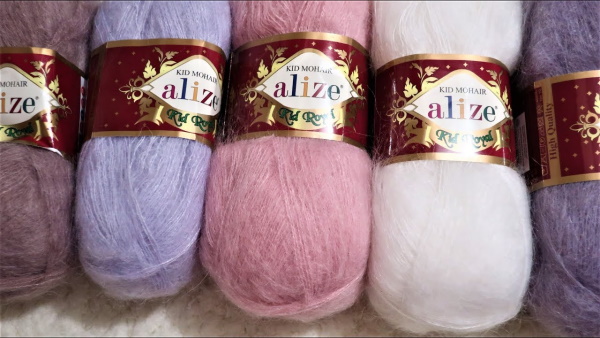
For example, garter stitch, stockinette stitch. You can knit a rib (patent, false, Polish, Canadian, semi-patent, Italian). The simplest model of a hat implies the presence of a seam at the back. To do this, knit a piece of fabric, which is sewn together at the final stage with a thick needle or crochet hook.
| Mohair yarn | |
| Advantages | Flaws |
| · Excellent heat retention. · Durable. · Takes color well. · Light. · Elastic. · Does not irritate the skin, does not prick. · Has a natural shine. · Rarely forms pellets. | · Deforms when washed in a washing machine.
· Falls down. · Shrinks when washed. · Requires careful care. |
The finished hat does not need to be steamed with a hot iron. It is better to slightly moisten it with clean water from a spray bottle, having previously put the headdress on a mannequin or a jar. The hat should be washed by hand, without wringing it out in a washing machine. To fluff up the mohair, you need to carefully comb the product with a clothes brush.
Voluminous hat
Mohair hats with knitting needles (knitting patterns will help you make a voluminous headdress yourself, which will add femininity, tenderness and romanticism to your image) will turn out more voluminous and warm if you knit the fabric in 2-3 threads at once. Free knitting and loose loops will help highlight the beautiful texture of the product. When choosing a suitable knitting method, you should give preference to a 1x1 elastic band. You need to knit edge loops.
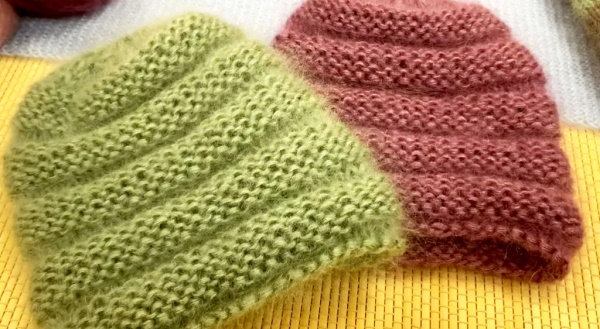
The pattern creation scheme looks like this:
- When knitting the first row, alternate purl and knit stitches.
- In the second row, knit the front loop first, and throw the back loop onto another knitting needle without knitting. You need to make a yarn over (yarn behind the work) and repeat the sequence of actions again.
- In the third row, the front loop is thrown onto the adjacent loop so that the next loop together with the yarn over is knitted with the front surface. The entire row is knitted according to this pattern.
In the process of making a hat, rows 2 and 3 are a pattern rapport that must be repeated until the end of the product. If the presence of a lapel is not provided, then the uniform decrease of loops begins only after 18 cm. Loops are allowed not to be removed, but then the edges of the fabric will need to be knitted and the top smoothly pulled together.
To knit a voluminous hat without a seam, you need to have circular knitting needles. After the first row, connect 2 outer loops at once into 1 and continue knitting in a circle. Beginner needlewomen should take into account that they will have to work only with the front side of the headdress, due to which it will be easier to knit interesting patterns.
With a lapel
A stylish hat with a wide lapel will definitely complement the image of both a young girl and an older woman. In the process of work, you can use medium and large knitting. At the peak of popularity this winter will be hats with a lapel, knitted with a 1x1 elastic band.
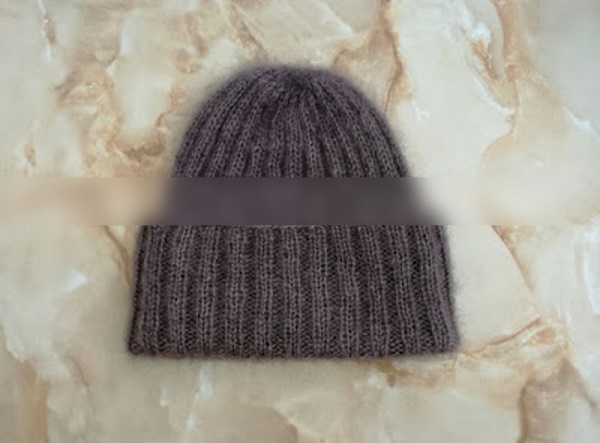
In this case, the rows are neat and refined. This headdress is called TakOri. The hat can have 1 or 2 lapels. In both cases, the same knitting patterns are used, since the only difference is in the length of the product.
To work you need to prepare:
- Knitting needles.
- Hook.
- Mohair yarn.
- A medium sized bead.
Before you start knitting, you need to decide on 2 measurements: the circumference and the depth of the hat. The head circumference is measured so that the measuring tape is located 1-2 cm above the eyebrows. To ensure that the hat fits well against the ears and does not hang loose, you need to subtract 2 cm from the resulting value. To correctly determine the depth of the future product, the centimeter line is applied along the line from the eyebrows to the base of the back of the head.
The resulting value is divided by 2. The height of the product can be increased, but it is not recommended to decrease it. You need to cast on loops on circular knitting needles, the number of which will correspond to the circumference of the hat. Knit in circular rows to get a 3x1 elastic band. Switch to the second pattern (2x1 elastic) only after the lower third of the headdress is knitted.
The second third of the hat is knitted with a 2x1 elastic band and then the pattern is changed to a 1x1 pattern. Only 1/2 of the product is knitted with this elastic band so that in every 4th row there are 6-loop decreases.
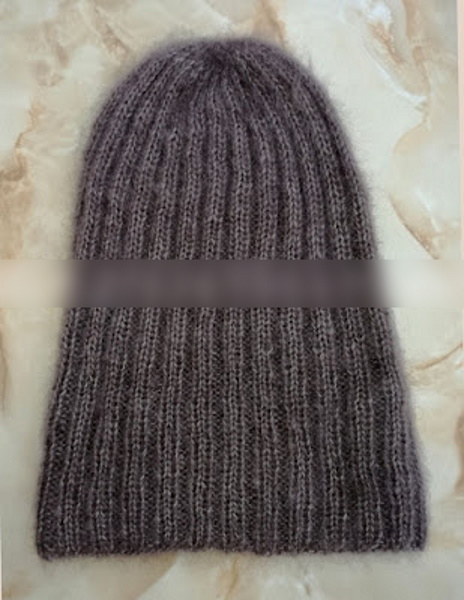
The fabric is knitted to the desired length, and then all the loops are collected into one. All that remains is to tighten the thread and the hat with a lapel is ready. A flower will help to add originality to the headdress, 5 petals of which are knitted with a hook, and then sewn to the hat one by one. At the final stage, a bead is sewn into the center of the flower. After the manipulations are done, it remains to try on the stylish hat.
Seamless
You can knit a practical, warm, seamless hat yourself, even if you have never encountered this type of needlework before. To do this, you need to prepare yarn and circular knitting needles, and also follow the step-by-step scheme of actions. The principle of creating a headdress is to connect 2 outer loops into 1 after the first row and continue knitting in a circle. You will only have to work with the front side, due to which it is much easier to create complex, multifaceted patterns.
Since the product will be seamless, there will be no edge loops. If you knit in 2 threads, you will need about 120 g of yarn for work. The headdress will be elastic, so you don’t have to worry about the loop calculations having errors. The main thing is that the number of loops is even.
If you have to work with 54 loops, then you should cast on 55 loops on the knitting needles and close them into a ring. You need to make sure that the workpiece does not twist, and pull the last loop through the first. Due to this, the extra loop will go away. To avoid getting confused in the rows, you need to mark the joint with a sewing pin or colored thread.
The seamless hat is knitted with a 1x1 elastic band according to the following pattern:
- Row #1: 1 yarn over, 1 slip stitch (the thread should be behind the fabric), 1 knit stitch.
- Row #2: 1 purl stitch, knit the yarn over together with the next adjacent stitch. Make 1 yarn over again, remove 1 stitch without knitting. Knit all even rows in the same way. The thread should be behind the fabric.
- Row #3 And next Odd rows are knitted as follows: 1 yarn over, 1 stitch is removed without being knitted, 2 stitches of the previous row are knitted together with the front surface.
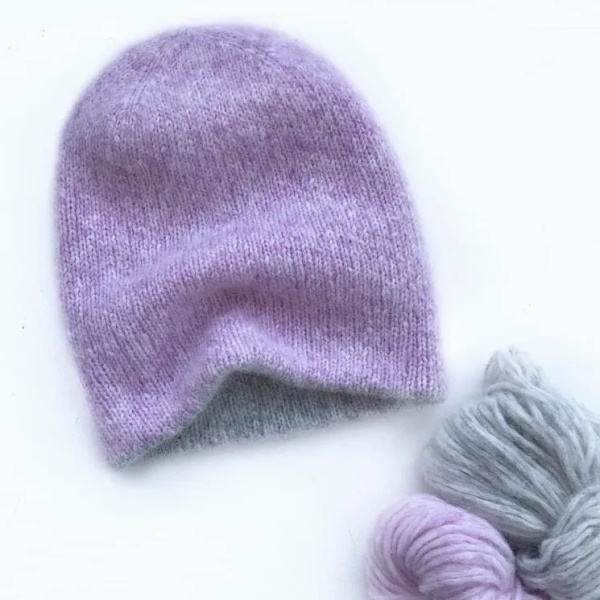
The following 27 cm of the product are knitted according to this pattern. For uniform decreases, the hat blank is divided into 6 equal fragments, so that at the end of each of them, 2 loops are knitted with the front surface. All other loops should be front. According to this principle, decreases are made until there are several loops left in the work, which are pulled together and fixed.
In a similar way, you can knit a seamless hat model yourself, but with a lapel. The patterns on the main part and the hem can be different. The lapel can be knitted with a 1x1 elastic band. The hat will look neat if, when switching to English elastic in the center of the product, you dial 6 more loops at equal intervals.
Beanie hat
The mohair beanie has been at the peak of popularity for several years now. The most popular are tight-fitting versions of headwear and elongated models with a lowered crown, which can be knitted with knitting needles according to the pattern in just 3-4 days. A universal product from the unisex category is a double hat, which is knitted from high-quality Italian mohair using classic stocking stitch.
A headdress in gray, black, brown or white will perfectly complement the image of not only a woman, but also a man. If the hat is worn by a representative of the fair sex, then the product can be decorated with voluminous braids and other patterns, as well as sequins, beads.
Beginner needlewomen can try knitting a beanie hat with a Hyacinth pattern. If you follow the suggested pattern, you will end up with a stylish headdress that will suit anyone with a head circumference of 55-56 or 57-58 cm. To work, you need to prepare yarn, circular knitting needles No. 2.5 and No. 3. The density of the product will be 10 cm - 24 loops.
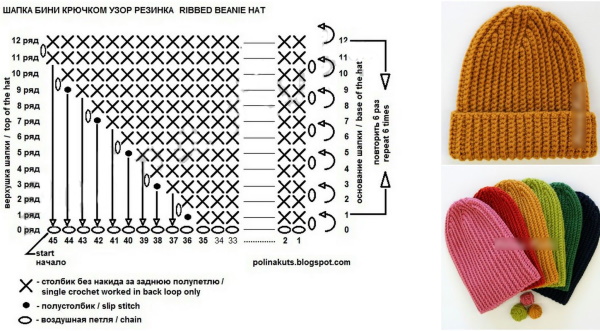
Scheme of actions:
- On smaller knitting needles, cast on 136/144 stitches in 2 additions. Row #1 is knitted with face stitches. The next 4 cm are knitted with a 2x2 rib pattern.
- You need to take larger knitting needles and continue knitting the hat with 1 thread. Knit 1 row with face loops, but at the same time decrease evenly (114/120 loops). Then knit in accordance with the selected pattern to get a piece of fabric 18 cm long.
- You need to knit 1 row again with face loops, making a decrease (100/110 loops).
- After 10-11 loops, place markers and continue knitting the hat in garter stitch (1 row with knit stitches, 2 rows with purl stitches). Before the marker, decrease 1 loop in all even rows. If there are no more than 30 loops left on the needles, then knit 2 loops together.
- The remaining loops are transferred to the working thread, carefully pulled together and secured.
Mohair beanies go well with voluminous fur coats and fur vests. To create an interesting look, stylists recommend choosing contrasting colors.
Beret
Mohair hats with knitting needles (knitting patterns from experienced needlewomen allow you to learn how to make stylish, original headdresses from the wool of Angora goats) will turn out beautiful and durable only if you use high-quality yarn. You can emphasize the femininity and romanticism of nature with a beret, which can be worn by women of all ages. For work, you need to prepare 100 g of yarn and knitting needles No. 5.5.
Decreases are made as follows:
- If the first loop is a purl, then you need to transfer 3 loops to the right knitting needle at once, and insert the left knitting needle into the second loop before knitting. Carefully pull the right knitting needle out of loops 1 and 3, picking up loop 2. Return all 3 loops to the left knitting needle and knit 3 loops behind the front wall with the front surface.
- If the first stitch is a knit stitch, then you immediately need to knit 3 stitches in knit stitch.
The density of the fabric should be 17 loops/10 cm.
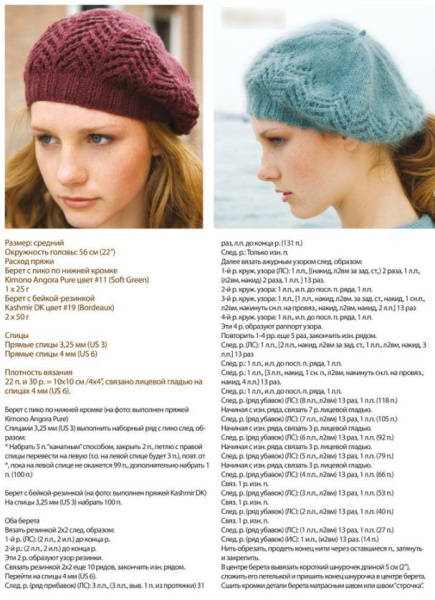
To knit a beret from mohair, you need to follow these steps step by step:
- Cast on 71 stitches and knit 21 rows with 1x1 rib pattern.
- Having reached the 22nd row, 34 loops should be added evenly in the front loops, so that in the end there are 105 loops in the work.
- The next 20 rows are knitted with a 1x2 elastic band.
- In row 43, 34 loops are added to all front loops. The next 14 rows are knitted with a 1x3 elastic band.
- In row 57, decrease every 2 front loops by knitting them together. Knit 10 rows with 1x2 elastic.
- In row 67, make the same decreases as in point No. 5. The next 8 rows are knitted according to the pattern.
- In row 85, knit 2 loops at a time.
- In row 86, decreases are repeated.
- All loops are collected on the working thread and secured.
A beret made of high-quality mohair is more pleasant to the touch and warmer than similar headwear made of other materials. Decorative elements will help to add originality to the product. For example, beads of different sizes and colors, sequins, rhinestones.
Pipe hat
This headdress is a large diameter cylinder that does not fit tightly around the head and neck. Knitting such a hat does not require much time and high qualifications.
To ensure that the final result meets expectations, the following recommendations should be taken into account:
- As a sample, you should cast on 20 loops and knit 20 rows with a 2x2 elastic band. You need to measure the width + height of the fabric to calculate the required number of loops to create the desired product. It is better to use cotton yarn to work with the sample.
- You can start knitting the headdress from the side seam or from the top. The brighter the yarn, the better the pattern will look. Large relief patterns are best placed across the hat, starting to knit the product from the side seam. Experienced needlewomen recommend making sure that the patterns on both sides of the headdress are as similar as possible. Beginner needlewomen are better off knitting the product with English or French elastic.
- The edges of the tube hat need to be tied with a crochet hook or a regular thick needle.
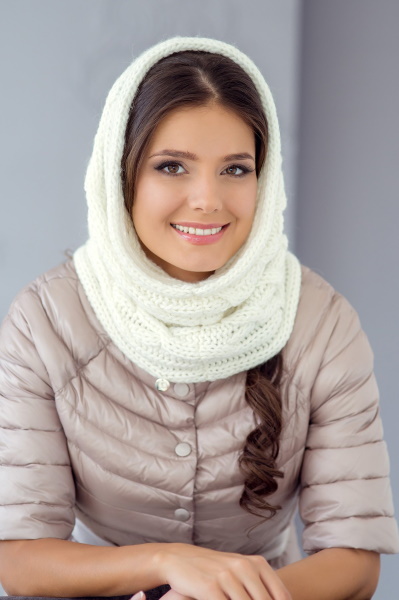
The standard size of the fabric for such a headdress is 110 cm in width and 60 cm in height. You need to cast on 140-160 loops on the knitting needles (it all depends on the results of the calculations made earlier) and knit 20 rows with the front surface. In this way, the upper edge of the hat is knitted. As a pattern, you can choose a French elastic band, which is easy to knit, and it looks beautiful and voluminous.
Scheme of actions:
- Row #1: 2 front loops + 2 back loops. Knit the 3rd row in a similar way.
- Row #2: 2 front loops + 2 back loops shifted exactly by 1 loop. Knit the 4th row in the same way.
The clear relief of the pattern is created by the fact that 2 loops located next to each other are alternately knitted with the front and back surface in each row. It is necessary not to tighten the loops in the first row (you can cast them on 2 different knitting needles). The main pattern is located in the middle of the tube hat, and 2 stripes are formed on the sides, which form the upper and lower edges (they can be knitted with an elastic band or garter stitch).
Mohair hats with knitting needles (knitting patterns help to avoid mistakes when creating beautiful, complex patterns) can be made using the principle of combined knitting. First, the fabric is knitted with any pattern you like, and at the final stage, the top and bottom of the product are bound. Both knitting needles and a crochet hook are suitable for binding. In this case, the hat will look as harmonious as possible if the last row is made with a crayfish loop.
Turban
A turban made of mohair yarn will help create an ultra-fashionable image. Beginner needlewomen can try to knit such a headdress using simple cotton yarn, since if you make a mistake, mohair threads are difficult to untangle without losing quality.
In the process of work, you do not need to limit yourself in the choice of knitting method and style, in addition, you can experiment with the technique:
- Volumetric elastic band.
- Stocking technique.
- English/French elastic.
- Relief patterns.
- Pearl pattern.
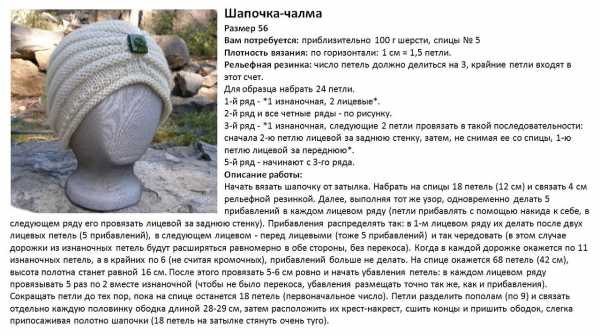
The hat can be made even more interesting if you knit an openwork pattern, a large braid or plait.
The simplest pattern for knitting a turban from mohair looks like this:
- All loops are knitted according to the principle: 3 front + 1 back. Cast on 31 stitches.
- Row #1: knits 3 front loops, 1 back loop and again 3 front loops. Knit according to this pattern until the end of the row.
- Row #2: 1 knit, 1 purl and 3 knit stitches. This combination is repeated to the end of the row.
All these stages are repeated sequentially until the length of the fabric of the future turban reaches 102 cm.
The resulting scarf should be tied on the head, crossing and twisting the ends on the forehead, which are pulled to the back of the head and fixed with a pin. All the gaps on the turban should be sewn so that it becomes a solid hat. After this, the stylish headdress in the oriental style is ready for the first fitting. A knitted turban is perfect for creating a stylish spring or autumn look. You can combine this headdress with a coat, a down jacket, an elongated warm jacket and even a leather jacket.
Having detailed patterns and all the necessary materials, any woman can knit an original, warm mohair hat. Bright models of headwear are best combined with clothes of muted tones. And down jackets and fur coats of rich shades will perfectly complement hats of neutral colors. Decorative elements that can be used to decorate a headdress of any model will help to emphasize individuality.
Video about making a hat from mohair with knitting needles
How to knit a mohair hat with knitting needles:
